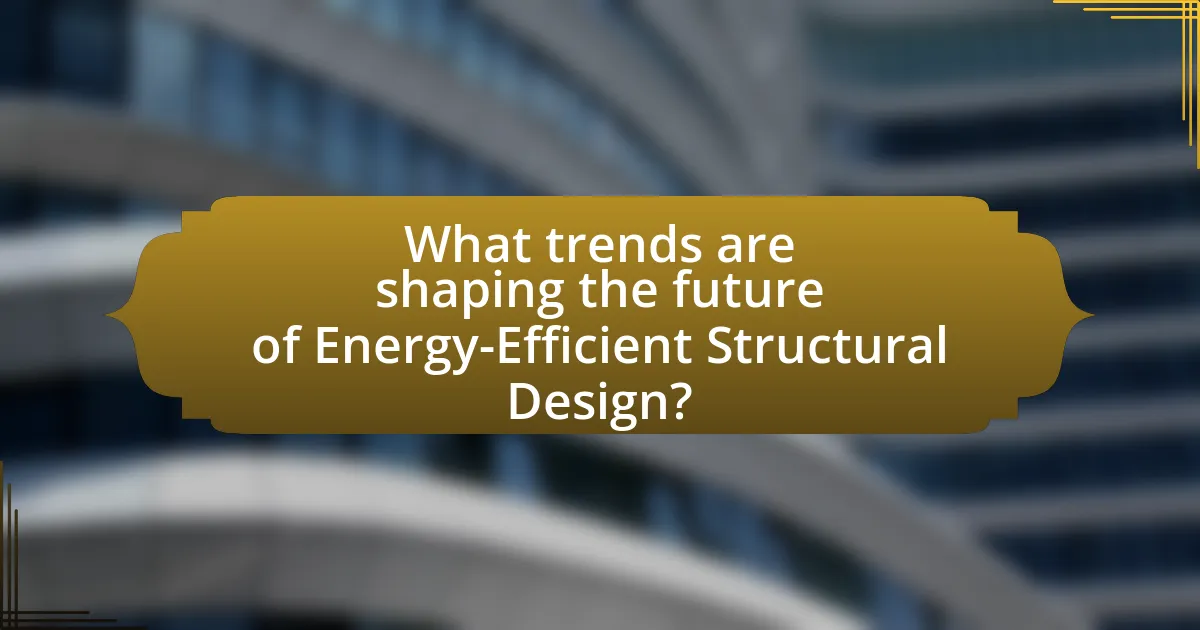Energy-efficient structural design is the practice of creating buildings that minimize energy consumption while maximizing performance and comfort. This article explores the principles and techniques of energy-efficient design, highlighting its contributions to sustainability, resource conservation, and reduced carbon footprints. Key topics include the use of advanced materials, passive design strategies, and the integration of renewable energy sources. Additionally, the article discusses the impact of technology, emerging practices, and the significance of net-zero energy buildings in shaping modern architecture. Practical tips for implementing effective energy-efficient design strategies are also provided, emphasizing their role in reducing operational costs and environmental impact.

What is Energy-Efficient Structural Design?
Energy-efficient structural design refers to the practice of creating buildings and structures that minimize energy consumption while maximizing performance and comfort. This approach incorporates sustainable materials, optimized building orientation, and advanced insulation techniques to reduce reliance on heating, cooling, and lighting systems. For instance, studies indicate that energy-efficient designs can lead to a reduction in energy use by up to 30% compared to traditional designs, as reported by the U.S. Department of Energy.
How does Energy-Efficient Structural Design contribute to sustainability?
Energy-efficient structural design significantly contributes to sustainability by minimizing energy consumption and reducing greenhouse gas emissions throughout a building’s lifecycle. This design approach incorporates materials and techniques that enhance thermal performance, optimize natural light usage, and improve energy efficiency, leading to lower operational costs and reduced reliance on non-renewable energy sources. For instance, buildings designed with passive solar principles can reduce heating and cooling demands by up to 50%, as reported by the U.S. Department of Energy. Additionally, energy-efficient designs often utilize sustainable materials, which further decreases environmental impact and promotes resource conservation.
What are the key principles of Energy-Efficient Structural Design?
The key principles of Energy-Efficient Structural Design include optimizing material use, enhancing thermal performance, and integrating renewable energy sources. Optimizing material use involves selecting sustainable materials and minimizing waste during construction, which can reduce the overall carbon footprint of a structure. Enhancing thermal performance focuses on improving insulation and reducing heat loss, thereby lowering energy consumption for heating and cooling. Integrating renewable energy sources, such as solar panels or wind turbines, allows buildings to generate their own energy, further decreasing reliance on non-renewable resources. These principles are supported by studies indicating that energy-efficient designs can reduce energy costs by up to 30% and significantly lower greenhouse gas emissions.
How does Energy-Efficient Structural Design impact resource consumption?
Energy-efficient structural design significantly reduces resource consumption by optimizing materials and energy use throughout a building’s lifecycle. This design approach minimizes waste during construction, as it often employs sustainable materials and efficient construction techniques, leading to lower demand for raw resources. For instance, studies indicate that buildings designed with energy efficiency in mind can reduce energy consumption by up to 30% compared to conventional designs, which directly correlates to decreased resource extraction and processing. Additionally, energy-efficient structures often incorporate renewable energy sources, further diminishing reliance on non-renewable resources.
Why is Energy-Efficient Structural Design important in modern architecture?
Energy-efficient structural design is important in modern architecture because it significantly reduces energy consumption and environmental impact. This design approach utilizes materials and techniques that enhance thermal performance, optimize natural light, and improve ventilation, leading to lower operational costs and reduced greenhouse gas emissions. For instance, buildings designed with energy efficiency in mind can achieve up to 30% energy savings compared to traditional designs, as reported by the U.S. Department of Energy. This not only contributes to sustainability goals but also aligns with regulatory standards and consumer demand for greener buildings.
What role does Energy-Efficient Structural Design play in reducing carbon footprints?
Energy-efficient structural design significantly reduces carbon footprints by optimizing resource use and minimizing energy consumption throughout a building’s lifecycle. This design approach incorporates materials and techniques that enhance thermal performance, reduce reliance on non-renewable energy sources, and promote sustainable practices. For instance, buildings designed with passive solar heating and natural ventilation can decrease energy demand by up to 50%, as reported by the U.S. Department of Energy. Additionally, using sustainable materials, such as recycled steel or bamboo, can lower embodied carbon emissions associated with construction. Therefore, energy-efficient structural design plays a crucial role in mitigating climate change impacts by lowering overall greenhouse gas emissions.
How does Energy-Efficient Structural Design influence building regulations?
Energy-efficient structural design significantly influences building regulations by promoting standards that prioritize sustainability and energy conservation. These designs often lead to the establishment of codes that require enhanced insulation, energy-efficient materials, and renewable energy integration, thereby reducing overall energy consumption in buildings. For instance, the International Energy Conservation Code (IECC) sets forth guidelines that encourage energy-efficient practices, reflecting the growing emphasis on reducing carbon footprints in the construction industry. As a result, building regulations increasingly mandate compliance with energy efficiency benchmarks, which are informed by advancements in structural design techniques.

What are the latest techniques in Energy-Efficient Structural Design?
The latest techniques in energy-efficient structural design include the use of advanced materials, integrated building systems, and optimization software. Advanced materials such as high-performance insulation and energy-efficient glazing significantly reduce thermal loss, while integrated building systems, including smart HVAC and renewable energy sources, enhance overall energy efficiency. Optimization software allows for precise modeling and simulation of energy performance, enabling designers to make informed decisions that minimize energy consumption. These techniques are supported by research indicating that buildings designed with these methods can achieve energy savings of up to 30% compared to traditional designs.
How do passive design strategies enhance energy efficiency?
Passive design strategies enhance energy efficiency by utilizing natural resources for heating, cooling, and lighting, thereby reducing reliance on mechanical systems. These strategies include optimizing building orientation, using thermal mass, and incorporating natural ventilation, which collectively minimize energy consumption. For instance, a study by the U.S. Department of Energy indicates that buildings designed with passive solar principles can reduce heating and cooling energy use by up to 50%. This demonstrates that effective passive design not only lowers energy costs but also contributes to sustainability by decreasing greenhouse gas emissions.
What are the benefits of natural ventilation in Energy-Efficient Structural Design?
Natural ventilation significantly enhances energy-efficient structural design by reducing reliance on mechanical cooling systems. This method utilizes natural airflow to regulate indoor temperatures, leading to lower energy consumption and operational costs. Studies indicate that buildings designed with effective natural ventilation can achieve energy savings of up to 30% compared to those relying solely on mechanical systems. Additionally, natural ventilation improves indoor air quality by facilitating the exchange of stale air with fresh outdoor air, which is crucial for occupant health and comfort.
How can thermal mass be utilized effectively in building design?
Thermal mass can be effectively utilized in building design by incorporating materials that absorb and store heat, such as concrete, brick, or stone, which help regulate indoor temperatures. This regulation occurs through the thermal mass absorbing heat during the day and releasing it at night, thereby reducing the need for mechanical heating and cooling systems. Studies indicate that buildings designed with adequate thermal mass can achieve energy savings of up to 30% compared to conventional designs, as they maintain a more stable indoor climate.
What innovative materials are being used in Energy-Efficient Structural Design?
Innovative materials used in energy-efficient structural design include cross-laminated timber (CLT), recycled steel, and aerogel insulation. Cross-laminated timber is a sustainable alternative to traditional materials, providing high strength-to-weight ratios and reducing carbon footprints. Recycled steel offers durability and energy savings during production, while aerogel insulation is known for its exceptional thermal performance, significantly reducing energy consumption in buildings. These materials contribute to lower operational energy use and promote sustainability in construction practices.
How do recycled materials contribute to energy efficiency?
Recycled materials contribute to energy efficiency by reducing the energy required for manufacturing new products. The process of recycling typically consumes less energy compared to extracting and processing raw materials; for instance, recycling aluminum saves up to 95% of the energy needed to produce new aluminum from bauxite ore. Additionally, using recycled materials in construction can lead to lower energy consumption in buildings, as these materials often have better thermal properties, which enhance insulation and reduce heating and cooling demands. This energy efficiency not only lowers operational costs but also decreases greenhouse gas emissions associated with energy production.
What is the role of smart materials in modern structural design?
Smart materials play a crucial role in modern structural design by enabling structures to adapt to changing environmental conditions and loads. These materials, such as shape memory alloys and piezoelectric materials, respond dynamically to stimuli, enhancing the performance and longevity of structures. For instance, smart materials can self-heal, reduce vibrations, and optimize energy consumption, which contributes to energy-efficient design. Research indicates that integrating smart materials can lead to a reduction in maintenance costs and an increase in structural resilience, as evidenced by studies showing that buildings utilizing these materials can withstand extreme weather events more effectively.

What trends are shaping the future of Energy-Efficient Structural Design?
The future of energy-efficient structural design is being shaped by trends such as the integration of advanced materials, the use of building information modeling (BIM), and the emphasis on sustainable practices. Advanced materials, like high-performance insulation and energy-efficient glazing, enhance thermal performance and reduce energy consumption. Building information modeling facilitates better planning and resource management, allowing for optimized energy use throughout a building’s lifecycle. Additionally, sustainable practices, including the incorporation of renewable energy sources and green certifications, are increasingly prioritized, reflecting a growing commitment to environmental responsibility in construction. These trends collectively contribute to reducing the carbon footprint of buildings and improving overall energy efficiency.
How is technology influencing Energy-Efficient Structural Design?
Technology is significantly influencing energy-efficient structural design by enabling advanced modeling, simulation, and analysis tools that optimize building performance. These tools, such as Building Information Modeling (BIM) and energy simulation software, allow architects and engineers to assess energy consumption, daylighting, and thermal performance during the design phase. For instance, a study published in the Journal of Building Performance found that using BIM can reduce energy costs by up to 30% through improved design accuracy and efficiency. Additionally, smart materials and construction techniques, such as prefabrication and modular construction, further enhance energy efficiency by minimizing waste and improving insulation properties.
What advancements in building information modeling (BIM) are relevant?
Advancements in building information modeling (BIM) relevant to energy-efficient structural design include enhanced interoperability, real-time data integration, and advanced simulation capabilities. Enhanced interoperability allows different software platforms to communicate effectively, facilitating collaboration among architects, engineers, and contractors, which is crucial for optimizing energy performance. Real-time data integration enables the incorporation of live data from building sensors, allowing for immediate adjustments to energy systems based on actual usage patterns. Advanced simulation capabilities, such as energy modeling and performance analysis, enable designers to predict energy consumption and optimize designs for efficiency before construction begins. These advancements collectively contribute to more sustainable building practices and improved energy efficiency outcomes.
How do energy modeling tools enhance design efficiency?
Energy modeling tools enhance design efficiency by providing accurate simulations of energy consumption and performance in buildings. These tools allow architects and engineers to analyze various design options, optimize energy use, and identify potential issues early in the design process. For instance, a study by the National Renewable Energy Laboratory found that using energy modeling can lead to a 20-30% reduction in energy costs by enabling informed decisions on materials, orientation, and systems. This data-driven approach ensures that designs meet energy efficiency standards while minimizing waste and maximizing performance.
What are the emerging practices in Energy-Efficient Structural Design?
Emerging practices in energy-efficient structural design include the use of advanced materials, integrated building systems, and innovative design methodologies. Advanced materials such as high-performance insulation and sustainable concrete reduce energy consumption by enhancing thermal performance. Integrated building systems, which combine heating, cooling, and lighting into a cohesive framework, optimize energy use and improve occupant comfort. Innovative design methodologies, including parametric design and building information modeling (BIM), facilitate energy analysis and promote sustainable practices throughout the design process. These practices are supported by research indicating that energy-efficient designs can reduce operational energy use by up to 50%, demonstrating their effectiveness in promoting sustainability in the built environment.
How is biophilic design integrated into energy-efficient structures?
Biophilic design is integrated into energy-efficient structures by incorporating natural elements that enhance occupant well-being while reducing energy consumption. This integration often includes features such as natural lighting, ventilation, and the use of sustainable materials that mimic natural environments. For instance, large windows and skylights allow for daylighting, which decreases reliance on artificial lighting and improves indoor air quality through natural ventilation. Studies show that buildings designed with biophilic principles can achieve up to 30% energy savings compared to conventional designs, as reported in the “Biophilic Design: The Architecture of Life” by Stephen Kellert. This evidence supports the effectiveness of biophilic design in promoting energy efficiency while fostering a connection to nature.
What is the significance of net-zero energy buildings in current trends?
Net-zero energy buildings are significant in current trends as they represent a critical advancement towards sustainability in the construction industry. These buildings are designed to produce as much energy as they consume over a year, thereby minimizing their environmental impact. According to the U.S. Department of Energy, net-zero energy buildings can reduce energy costs by up to 80% compared to conventional buildings, highlighting their economic viability. Furthermore, the global push for reducing greenhouse gas emissions aligns with the adoption of net-zero energy buildings, as they contribute to climate goals set by international agreements such as the Paris Agreement. This trend is further supported by increasing consumer demand for sustainable living spaces, making net-zero energy buildings a pivotal element in the future of energy-efficient structural design.
What practical tips can be applied for effective Energy-Efficient Structural Design?
Effective energy-efficient structural design can be achieved by implementing strategies such as optimizing building orientation, utilizing high-performance insulation, and incorporating renewable energy sources. Optimizing building orientation involves positioning structures to maximize natural light and minimize heat loss, which can reduce energy consumption by up to 30% according to the U.S. Department of Energy. High-performance insulation materials, such as spray foam or rigid foam boards, can significantly lower heating and cooling demands, enhancing overall energy efficiency. Additionally, integrating renewable energy systems, like solar panels or wind turbines, can provide sustainable energy solutions, further decreasing reliance on non-renewable resources. These practical tips collectively contribute to a more energy-efficient built environment.

Leave a Reply